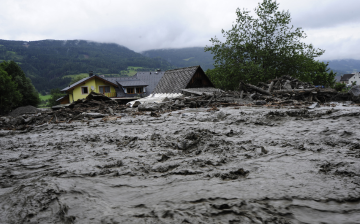
Case Study | Uttarakhand’s Tragedy | GRMI
Case Study | Uttarakhand's Tragedy
Overview of the Flood Event in 2025
Uttarakhand witnessed one of its worst flood events at the beginning of July 2025. Towns such as Joshimath, Chamoli, and Rudraprayag were devastated due to landslides and floods. Heavy rainfalls created storms and floods in multiple districts at the end of June. Thousands were stranded as villages were flooded, roads were washed away, and electrical lines failed.
The devastation and overall impact of the floods were on par with dozens of other disasters in this region. This makes evident the pressing need for urgent disaster risk communication mechanisms.
Disruption to Economic Life, Infrastructure, and Human Losses
The floods of 2025 caused an unfathomable loss of human life. More than 15,000 people were displaced, and over 300 lives were lost. There was widespread damage to infrastructure — roads, bridges, schools, and hospitals were all severely disrupted.
The economic toll is estimated to be in excess of ₹12,000 crore. In addition to the immediate losses incurred, the flood disaster revealed the fragility of development in ecologically sensitive zones.
Why Risk Management Needs More Attention in Light of This Incident
The disaster once again demonstrated the urgent need for risk management practices. Uttarakhand continues to show a troubling pattern of recurring natural disasters. While such disasters may be inevitable, our failure to adopt preventive measures turns them into humanitarian crises.
This lends credence to the need for integrating risk management into professional education, especially where environmental threats are significant.
Why Did the Flood Occur in Uttarakhand?
Natural Reasons
Heavy monsoon rainfall and the possibility of a Glacial Lake Outburst Flood (GLOF) were the primary natural causes of the 2025 floods. The risk of GLOFs has increased due to glacial melting, which is accelerating because of climate change and rising global temperatures.
Human Factors
The instability of slopes increased due to widespread deforestation for road construction and tourism infrastructure. Mismanagement of dams and unchecked construction in flood-prone regions also contributed to the scale of the disaster.
Poor planning that failed to consider ESG (Environmental, Social, and Governance) risk management principles has heightened the vulnerability of these already fragile ecosystems.
Comprehending Flood Risk Management
Flood risk management is the methodical process of identifying, evaluating, and reducing flood risks in order to protect people, property, and the environment.
Crucial Components
- Vulnerability Identification: Recognizing areas susceptible to flooding.
- Assessment of Risk: Evaluating the probability and consequences of floods.
- Mitigation: Initiating actions to reduce risk (e.g., retention basins, levees).
- Preparedness: Planning and allocating resources for emergencies.
- Response: Taking appropriate action during disasters.
The application of these elements is crucial in states like Uttarakhand to reduce the impact of natural disasters.
Important Flaws in the Current System
Absence of Early Warning Systems
Despite meteorological advancements, early warnings failed to reach impacted populations in time. A modern flood warning system could have saved many lives.
Inadequate Disaster Preparedness
Evacuation plans and rescue operations had evident shortcomings. Emergency supplies were insufficient, and relief camps were overcrowded and ill-equipped.
Poor Planning and Infrastructure
Several development projects ignored risk-sensitive land-use planning. Haphazard urbanisation in steep terrain made many villages particularly vulnerable to disaster.
Lack of Effective Risk Communication
The local population was unaware of the true magnitude of the threat. The timely dissemination of risk information—an essential component of risk management—was largely absent.
How Might Things Have Been Handled Differently?
Real-Time Weather Monitoring
Satellite tracking and improved radar systems could help predict rainfall intensity and identify potential landslides in advance.
Stronger Construction Codes
By enforcing region-specific building standards, the risk of structural collapse in vulnerable areas could be significantly reduced.
Better Inter-Agency Coordination
The lack of coordination between state, central, and local agencies delayed the disaster response. A unified disaster response protocol is essential.
Investment in Resilient Infrastructure
Using elevated structures and flood-resistant materials could reduce future damage. Incorporating ESG risk management into urban planning could substantially lower vulnerability.
Global Best Practices in Flood Risk Management
Japan
Japan uses real-time hazard maps, conducts public drills, and has underground flood diversion systems as part of its advanced flood management strategy.
Netherlands
With two-thirds of the country below sea level, the Netherlands manages flood risk through zoning laws, surge barriers, and dikes.
Bangladesh
Flooding is frequent in Bangladesh, yet the death toll has decreased over time thanks to community-based risk education and early warning systems.
These examples demonstrate how strategic flood risk management can protect lives and infrastructure.
Policy and Community-Level Recommendations
Government-Level Measures
- Strengthen the Disaster Management Act
- Increase investments in early warning systems
- Promote public-private partnerships for resilient infrastructure development
Community-Level Actions
- Promote regional risk management training
- Educate residents about evacuation protocols
Involve youth in disaster simulation drills
The Impact of Climate Change and Future Threats
Climate change has made weather patterns more unpredictable. Rising temperatures, erratic monsoons, and melting glaciers are making floods more frequent and severe.
It is now essential to integrate climate models into disaster preparedness frameworks at both the national and state levels. Risk management systems must be adaptive and responsive to evolving environmental conditions.
Developing a Career in Risk Management: What Makes GRMI Unique
The Global Risk Management Institute (GRMI) is India’s leading institution offering a specialized Post Graduate Diploma in Risk Management (PGDRM). Unlike traditional academic programs, the PGDRM is designed by global risk experts and is industry-focused.
It provides students with hands-on experience across financial, operational, cyber, and ESG risk management. Real-world case studies, internships, and workshops led by experienced professionals are integrated into the program.
Whether you’re a fresher or a working professional, PGDRM prepares you to excel in the evolving field of risk management. GRMI’s strong corporate connections ensure high placement success.
The Significance of GRMI’s Post Graduate Diploma in Risk Management Course
- Recognized as one of India’s top programs in risk management
- Covers emerging areas like ESG risk and climate-related risks
- Offers exclusive networking opportunities with industry leaders
For those who truly want to contribute to preventing future tragedies like the Uttarakhand floods, GRMI’s PGDRM provides the vision and tools required.
Increasing the Talent Pool for Risk Management in India
Given the growing frequency and intensity of natural disasters, India urgently needs a new generation of skilled professionals in disaster risk management.
Developing academic curricula that reflect real-world risks will require collaboration between government bodies and private institutions.
Institutions like GRMI are already leading this charge by providing both practical and theoretical training. Expanding this model to more sectors can significantly improve disaster preparedness.
Conclusion: Turning Tragedy Into a Roadmap for the Future
The 2025 Uttarakhand flood was a tragic reminder of how much more needs to be done. Improved planning, public awareness, and better infrastructure could have mitigated the damage and loss of life.
This should not be just another statistic in disaster records. It must become a lesson in prevention, resilience, and reform.
Adopting expert-led, globally informed risk management strategies is crucial. Investing in education through programs like GRMI’s PGDRM can empower India to build resilient communities, especially in disaster-prone areas.
Let the events of 2025 serve not just as a memory, but as a catalyst for a safer and more prepared future.

You may also like

How Specialized PG Programs Are Bridging the Industry–Academia Skill Gap

How to Become a Cybersecurity Analyst in India


